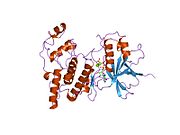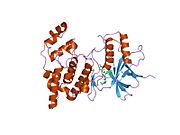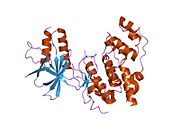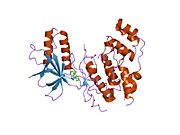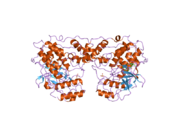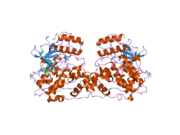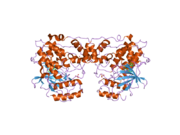Biology:MAPK8
 Generic protein structure example |
Mitogen-activated protein kinase 8 (also known as JNK1) is a ubiquitous enzyme that in humans is encoded by the MAPK8 gene.[1][2]
Function
The protein encoded by this gene is a member of the MAP kinase and JNK family. MAP kinases act as an integration point for multiple biochemical signals, and are involved in a wide variety of cellular processes such as proliferation, differentiation, transcription regulation and development. This kinase is activated by various cell stimuli, and targets specific transcription factors, and thus mediates immediate-early gene expression in response to cell stimuli. The activation of this kinase by tumor-necrosis factor alpha (TNF-alpha) is found to be required for TNF-alpha-induced apoptosis. This kinase is also involved in UV radiation-induced apoptosis, which is thought to be related to the cytochrome c-mediated cell death pathway. Studies of the mouse counterpart of this gene suggested that this kinase play a key role in T cell proliferation, apoptosis and differentiation. Four alternately spliced transcript variants encoding distinct isoforms have been reported.[3] MAPK8 contains multiple amino acid sites that are phosphorylated and ubiquitinated.[4]
Interactions
MAPK8 has been shown to interact with:
- Activating transcription factor 2,[5][6][7][8]
- C-jun,[1][8][9][10][11][12][13][14]
- CRK,[15]
- DUSP10,[16]
- DUSP1,[17]
- DUSP22,[18]
- GSTP1,[19]
- IRS1,[20][21]
- ITCH, [22][23]
- MAP2K4,[7][8][24][25][26]
- MAP2K7,[8][24]
- MAP3K1[27]
- MAP3K2,[24]
- MAPK8IP1,[28][29]
- MAPK8IP3,[30][31]
- Myc,[32]
- REL,[9]
- SH3BP5,[33] and
- SPIB.[34]
References
- ↑ 1.0 1.1 "JNK1: a protein kinase stimulated by UV light and Ha-Ras that binds and phosphorylates the c-Jun activation domain". Cell 76 (6): 1025–37. April 1994. doi:10.1016/0092-8674(94)90380-8. PMID 8137421.
- ↑ "Selective interaction of JNK protein kinase isoforms with transcription factors". EMBO J. 15 (11): 2760–70. July 1996. doi:10.1002/j.1460-2075.1996.tb00636.x. PMID 8654373.
- ↑ "Entrez Gene: MAPK8 mitogen-activated protein kinase 8". https://www.ncbi.nlm.nih.gov/sites/entrez?Db=gene&Cmd=ShowDetailView&TermToSearch=5599.
- ↑ "JNK1 (human)". https://www.phosphosite.org/proteinAction.action?id=613&showAllSites=true.
- ↑ "Pro-inflammatory cytokines and environmental stress cause p38 mitogen-activated protein kinase activation by dual phosphorylation on tyrosine and threonine". J. Biol. Chem. 270 (13): 7420–6. March 1995. doi:10.1074/jbc.270.13.7420. PMID 7535770.
- ↑ "c-Jun NH2-terminal kinases target the ubiquitination of their associated transcription factors". J. Biol. Chem. 272 (51): 32163–8. December 1997. doi:10.1074/jbc.272.51.32163. PMID 9405416.
- ↑ 7.0 7.1 "Regulation of stress-responsive mitogen-activated protein (MAP) kinase pathways by TAO2". J. Biol. Chem. 276 (19): 16070–5. May 2001. doi:10.1074/jbc.M100681200. PMID 11279118.
- ↑ 8.0 8.1 8.2 8.3 "Mitogen-activated protein kinase kinase 7 is an activator of the c-Jun NH2-terminal kinase". Proc. Natl. Acad. Sci. U.S.A. 94 (14): 7337–42. July 1997. doi:10.1073/pnas.94.14.7337. PMID 9207092. Bibcode: 1997PNAS...94.7337T.
- ↑ 9.0 9.1 "Interaction between c-Rel and the mitogen-activated protein kinase kinase kinase 1 signaling cascade in mediating kappaB enhancer activation". J. Biol. Chem. 271 (15): 8971–6. April 1996. doi:10.1074/jbc.271.15.8971. PMID 8621542.
- ↑ "Role of the TAB2-related protein TAB3 in IL-1 and TNF signaling". EMBO J. 22 (23): 6277–88. December 2003. doi:10.1093/emboj/cdg605. PMID 14633987.
- ↑ "ASK1 is essential for JNK/SAPK activation by TRAF2". Mol. Cell 2 (3): 389–95. September 1998. doi:10.1016/s1097-2765(00)80283-x. PMID 9774977.
- ↑ "Regulation of two JunD isoforms by Jun N-terminal kinases". J. Biol. Chem. 277 (33): 29710–8. August 2002. doi:10.1074/jbc.M204552200. PMID 12052834.
- ↑ "Critical roles of TRAF2 and TRAF5 in tumor necrosis factor-induced NF-kappa B activation and protection from cell death". J. Biol. Chem. 276 (39): 36530–4. September 2001. doi:10.1074/jbc.M104837200. PMID 11479302.
- ↑ "Neither ERK nor JNK/SAPK MAP kinase subtypes are essential for histone H3/HMG-14 phosphorylation or c-fos and c-jun induction". J. Cell Sci. 108 (11): 3599–609. November 1995. doi:10.1242/jcs.108.11.3599. PMID 8586671.
- ↑ "A direct interaction between JNK1 and CrkII is critical for Rac1-induced JNK activation". EMBO J. 20 (13): 3437–46. July 2001. doi:10.1093/emboj/20.13.3437. PMID 11432831.
- ↑ "Molecular cloning and characterization of a novel dual specificity phosphatase, MKP-5". J. Biol. Chem. 274 (28): 19949–56. July 1999. doi:10.1074/jbc.274.28.19949. PMID 10391943.
- ↑ "Distinct binding determinants for ERK2/p38alpha and JNK map kinases mediate catalytic activation and substrate selectivity of map kinase phosphatase-1". J. Biol. Chem. 276 (19): 16491–500. May 2001. doi:10.1074/jbc.M010966200. PMID 11278799.
- ↑ "Molecular cloning and characterization of a novel dual specificity phosphatase, LMW-DSP2, that lacks the cdc25 homology domain". J. Biol. Chem. 276 (29): 27575–83. July 2001. doi:10.1074/jbc.M100408200. PMID 11346645.
- ↑ "Glutathione S-transferase P1-1 (GSTP1-1) inhibits c-Jun N-terminal kinase (JNK1) signaling through interaction with the C terminus". J. Biol. Chem. 276 (24): 20999–1003. June 2001. doi:10.1074/jbc.M101355200. PMID 11279197.
- ↑ "Phosphorylation of Ser307 in insulin receptor substrate-1 blocks interactions with the insulin receptor and inhibits insulin action". J. Biol. Chem. 277 (2): 1531–7. January 2002. doi:10.1074/jbc.M101521200. PMID 11606564.
- ↑ "The c-Jun NH(2)-terminal kinase promotes insulin resistance during association with insulin receptor substrate-1 and phosphorylation of Ser(307)". J. Biol. Chem. 275 (12): 9047–54. March 2000. doi:10.1074/jbc.275.12.9047. PMID 10722755.
- ↑ "Jun turnover is controlled through JNK-dependent phosphorylation of the E3 ligase Itch". Science 306 (5694): 271–5. October 2004. doi:10.1126/science.1099414. PMID 15358865. Bibcode: 2004Sci...306..271G.
- ↑ "Activation of the E3 ubiquitin ligase Itch through a phosphorylation-induced conformational change". Proceedings of the National Academy of Sciences of the United States of America 103 (6): 1717–22. February 2006. doi:10.1073/pnas.0510664103. PMID 16446428. Bibcode: 2006PNAS..103.1717G.
- ↑ 24.0 24.1 24.2 "Synergistic interaction of MEK kinase 2, c-Jun N-terminal kinase (JNK) kinase 2, and JNK1 results in efficient and specific JNK1 activation". Mol. Cell. Biol. 20 (7): 2334–42. April 2000. doi:10.1128/mcb.20.7.2334-2342.2000. PMID 10713157.
- ↑ "JLP: A scaffolding protein that tethers JNK/p38MAPK signaling modules and transcription factors". Proc. Natl. Acad. Sci. U.S.A. 99 (22): 14189–94. October 2002. doi:10.1073/pnas.232310199. PMID 12391307. Bibcode: 2002PNAS...9914189L.
- ↑ "Akt (protein kinase B) negatively regulates SEK1 by means of protein phosphorylation". J. Biol. Chem. 277 (4): 2573–8. January 2002. doi:10.1074/jbc.M110299200. PMID 11707464.
- ↑ "MEKK1 binds directly to the c-Jun N-terminal kinases/stress-activated protein kinases". J. Biol. Chem. 272 (51): 32056–60. December 1997. doi:10.1074/jbc.272.51.32056. PMID 9405400.
- ↑ "Routing MAP kinase cascades". Science 281 (5383): 1625–6. September 1998. doi:10.1126/science.281.5383.1625. PMID 9767029.
- ↑ "Phosphorylation of Pax2 by the c-Jun N-terminal kinase and enhanced Pax2-dependent transcription activation". J. Biol. Chem. 277 (2): 1217–22. January 2002. doi:10.1074/jbc.M109663200. PMID 11700324.
- ↑ "JSAP1, a novel jun N-terminal protein kinase (JNK)-binding protein that functions as a Scaffold factor in the JNK signaling pathway". Mol. Cell. Biol. 19 (11): 7539–48. November 1999. doi:10.1128/mcb.19.11.7539. PMID 10523642.
- ↑ "Interaction of a mitogen-activated protein kinase signaling module with the neuronal protein JIP3". Mol. Cell. Biol. 20 (3): 1030–43. February 2000. doi:10.1128/mcb.20.3.1030-1043.2000. PMID 10629060.
- ↑ "Regulation of c-Myc through phosphorylation at Ser-62 and Ser-71 by c-Jun N-terminal kinase". J. Biol. Chem. 274 (46): 32580–7. November 1999. doi:10.1074/jbc.274.46.32580. PMID 10551811.
- ↑ "A new c-Jun N-terminal kinase (JNK)-interacting protein, Sab (SH3BP5), associates with mitochondria". Biochem. J. 367 (Pt 3): 577–85. November 2002. doi:10.1042/BJ20020553. PMID 12167088.
- ↑ "Differential phosphorylations of Spi-B and Spi-1 transcription factors". Oncogene 12 (4): 863–73. February 1996. PMID 8632909.
Further reading
- "The JNK Signaling Pathway (Molecular Biology Intelligence Unit)". Landes Bioscience 1: 1–97. 2006. ISBN 978-1587061202.
- "Signal transduction by the JNK group of MAP kinases". Cell 103 (2): 239–52. 2000. doi:10.1016/S0092-8674(00)00116-1. PMID 11057897.
- "Wiring the cell signaling circuitry by the NF-kappa B and JNK1 crosstalk and its applications in human diseases". Oncogene 26 (22): 3267–78. 2007. doi:10.1038/sj.onc.1210417. PMID 17496921.
External links
This article incorporates text from the United States National Library of Medicine, which is in the public domain.
 |
